|
||||||
|
BETULA. Birches. [Betulaceae] |
|
|
Three species of Betula are native to Britain - Dwarf Birch (B. nana), Silver Birch (B. pendula) and Downy Birch (B. pubescens). Paper birch (B. papyrifera) has been introduced. The BSBI provide a downloadable plant crib for Betula. Sixty-eight British miners are recorded on Betula. The agromyzid Phytobia cambii feeds in the cambium of Salix and Populus in Britain and also Alnus, Betula and Carpinus elsewhere. The yponomeutids Swammerdamia passerella and Swammerdamia caesiella are recorded spinning the leaves of Betula and feeding on the leaf surface. A key to the Eriocranid miners on birch has recently been produced by Rob Edmunds in the British leafminers Newsletter. A key to the European miners recorded on Betula is provided in Bladmineerders van Europa. |
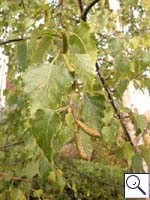 Silver Birch Betula pendula |
Key for the identification of the known mines of British |
Note: Diptera larvae may live in a corridor mine, a corridor-blotch mine, or a blotch mine, but never in a case, a rolled or folded leaf, a tentiform mine or sandwiched between two more or less circular leaf sections in later instars. Pupation never in a cocoon. All mining Diptera larvae are leg-less maggots without a head capsule (see examples). They never have thoracic or abdominal legs. They do not have chewing mouthparts, although they do have a characteristic cephalo-pharyngeal skeleton (see examples), usually visible internally through the body wall. The larvae lie on their sides within the mine and use their pick-like mouthparts to feed on plant tissue. In some corridor miners frass may lie in two rows on alternate sides of the mine. In order to vacate the mine the fully grown larva cuts an exit slit, which is usually semi-circular (see Liriomyza huidobrensis video). The pupa is formed within the hardened last larval skin or puparium and as a result sheaths enclosing head appendages, wings and legs are not visible externally (see examples). See Key to non-Diptera. |
1 > Leaf-miner: Larva forming a narrow, unusually long, upper surface leaf-mine up to 12 cms, sometimes considerably widening at end; young leaves are frequently distorted (Spencer, 1976: 93, fig. 130). An unusually long, upper-surface corridor that widens only little and winds freely through the leaf. Frass in two neat rows. Pupation outside the mine; exit slit (always?) in the lower epidermis. A long, greenish, winding, upper surface gallery which sometimes broadens considerably at the end. |
|
Agromyza alnibetulae Hendel, 1931 [Diptera: Agromyzidae]. |
|
Key for the identification of the known mines of British |
Note: The larvae of mining Coleoptera, Hymenoptera and Lepidoptera may live in a corridor mine, a corridor-blotch mine, a blotch mine, a case, a rolled or folded leaf, a tentiform mine or sandwiched between two more or less circular leaf sections in later instars. Larva may pupate in a silk cocoon. The larva may have six legs (although they may be reduced or absent), a head capsule and chewing mouthparts with opposable mandibles (see video of a gracillarid larva feeding). Larvae of Hymenoptera and Lepidoptera usually also have abdominal legs (see examples). Frass, if present, never in two rows. Unless feeding externally from within a case the larva usually vacates the mine by chewing an exit hole. Pupa with visible head appendages, wings and legs which lie in sheaths (see examples). The Eriocraniidae species feeding on Birch can be separated if carefully examined using a hand lens. |
1a > Leaf-miner and case-bearer: The larva lives outside the mine, protected by a case, and feeds on the underlying plant tissues via a hole cut in the epidermis. From that point it eats away as much leaf tissue as it can reach without fully entering the mine. Mine does not contain frass (Coleophora species) |
1b > Leaf-miner, but not a case-bearer: The larva lives mainly inside the mine. Mine usually contains frass. In later instars the larva may live sandwiched between two more or less circular sections cut from the leaf. |
2a > Leaf-miner and case-bearer: The larva creates a succession of cases, in this instance fashioned from parts of a leaf. The final case is 11-13 mm long, slender, and fixed at 45° to the leaf surface, with anal end laterally compressed and bivalved. A slender, brown, spathulate leaf case, in the end about 13 mm long; mouth angle about 15°. Young case slender, not hooked. |
|
Coleophora alnifoliae Barasch, 1934 [Lepidoptera: Coleophoridae]. |
2b > Leaf-miner and case-bearer: The early case is tiny and the larva makes a series of tiny holes on the leaf. After overwintering it makes a shiny pistol shaped case in spring and window feeds. The young larva, before hibernation, makes tiny mines, sometimes tens in one leaf. After hibernation window feeding is done. In this latter stage the larva lives in a shining black pistol case of about 7 mm, that, with a mouth angle of 70°-80°, stands almost perpendicular on the leaf. |
|
Coleophora anatipenella (Hübner, 1796) [Lepidoptera: Bucculatricidae]. |
2c > Leaf-miner and case-bearer: Larva mines leaves in autumn. Spring feeding is by grazing, usually on the underside of larger leaves, or feeding on the edges of small leaves. The full-grown case is black, pistol-shaped, 7 mm long (British leafminers), rather like the closely related C. ibipennella, which feeds on oak. Indeed, at one time they were believed to be conspecific. Prior to hibernation the young larva makes full depth mines; in spring window feeding takes place. In its final stage the larva lives in a matt pistol case about 7 mm in length, that with a mouth angle of 30°-45° is standing obliquely on the leaf. |
|
Coleophora betulella Heinemann, 1877 [Lepidoptera: Coleophoridae]. |
2d > Leaf-miner and case-bearer: Larva mines leaves. The case is enlarged several times by mining a leaf-edge and inserting the existing case into the mine which is joined with silk. The final case is 7-8 mm long. Larva in a composite leaf case, composed of large leaf fragments. Characteristically, the leaf fragments are attached in a failry untidy way. In spring the case has two colours, because the old material (dull yellowish, grey or pink) dates from before the hibernation, while new, reddish brown material dates from after the winter. The case finally is about 7-8 mm long; the mouth angle is 40-45°.. |
|
Coleophora binderella (Kollar, 1832) [Lepidoptera: Coleophoridae]. |
2e > Leaf-miner and case-bearer: The full grown larva lives in a dull black pistol case of c 9 mm that, with a mouth angle of 80-90° stands erect on the leaf. Characteristic is the presence of some ear-like flaps. At least after the hibernation the larvae do not mine any more, but rather cause skeleton feeding. |
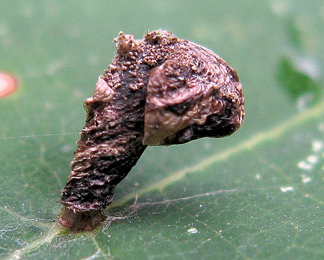 Case of Coleophora currucipennella on Quercus rubra Image: © Paul van Wielink (Bladmineerders van Europa) |
|
Coleophora currucipennella Zeller, 1839 [Lepidoptera: Coleophoridae]. |
2f > Leaf-miner and case-bearer: Lobe case. Many small leaf fragments are attached to the tubular case; its end is strongly curved downwards. The larvae are attached to the leaf underside, where they make a large number of relatively small full depth mines. |
|
Coleophora fuscocuprella Herrich-Schäffer, 1855 [Lepidoptera: Coleophoridae]. |
2g > Leaf-miner and case-bearer: As with other Coleophorids, the larva forms a case from the leaf, in which it overwinters. The case formed by this species is long, slender and frequently woolly in appearance. Bivalved composite leaf case of 8-10 mm, rather strongly compressed and keeled, with a mouth angle of 30-45°. |
|
Coleophora lusciniaepennella (Treitschke, 1833) [Lepidoptera: Coleophoridae]. |
2h > Leaf-miner and case-bearer: Larva mining leaves, the blotches brownish. The final case is 8-11 mm long, slender, and fixed at 45° to leaf surface, with anal end laterally compressed. The case has a serrated keel due to formation from the edge of a leaf. Spatulate leaf case. Strikingly slender, bivalved case, 8-11 mm long, with a slight curve at the rear end, that is keeled and often toothed. The end is laterally compressed. Mouth angle 45°. The full depth mines often are conspicuously brown. |
|
Coleophora milvipennis Zeller, 1839 [Lepidoptera: Coleophoridae]. |
2i > Leaf-miner and case-bearer: Composite leaf case. The material used to enlarge the case consists of large pieces of full depth mine, that are attached with such precision that they may seem seemless. In the course of summer an autumn two (sometimes three, according to Hering, 1927b) pieces are added. No more material is added after hibernation, causing the case in spring to be rather uniformly coloured (contrary to C. binderella, that does add an extension in spring, and is made of fresh leaf material). |
 Case of Coleophora orbitella on Betula pendula Image: © Willem Ellis (Bladmineerders van Europa) |
|
Coleophora orbitella Zeller, 1849 [Lepidoptera: Coleophoridae]. |
2j > Leaf-miner and case-bearer: The case resembles that of C. violacea, but does not lie so flat again the leaf as this species (having a mouth angle of 30 to 50°). C. violacea also has a case which bulges in the middle, whereas in C. potentillae the case tapers towards the posterior. Immediately after emergence the larva makes a full depth, quickly widening, corridor, with frass as small grains in a broad central band. Finally results a blotch of 2 x 5 mm, from which the youth case is cut. The fully developed case is a hairy, greyish brown to silver grey lobe case of about 1 cm long, with a clearly laterally compressed end; the mouth angle is about 90°. The case is difficult to separate from that of C. ochripennella. |
|
Coleophora potentillae Elisha, 1885 [Lepidoptera: Coleophoridae]. |
2k > Leaf-miner and case-bearer: Tubular leaf case, 6-7 mm long, light, later dark brown, trivalved, with a mouth angle of 45°. The larva lives at the underside of the leaf, and makes sizable full depth mines there. |
|
Coleophora prunifoliae Doets, 1944 [Lepidoptera: Coleophoridae]. |
2l > Leaf-miner and case-bearer: The larva feeds by inserting its head into small mines it creates on the leaves of birch, elm, alder, or hazel. Occasionally it is found feeding on other trees, or on herbaceous plants onto which it has accidentally Fallén. It forms two cases during its larval life. The first case is initially curved, smooth, laterally compressed with a bivalved anal opening, and about 2 mm long in September. During October it feeds, and adds a few rough collars of larval material around the oral opening. After hibernation, it feeds again in April and early May, adding more protruding collars until they equal or exceed the original smooth part of the case. At the same time, it expands the case girth by the creation of a silk gusset ventrally. The second case, 6 or 7 mm long, is formed in May, leaving the vacated first case attached to its last feeding mine. The new case is tubular with a trivalved crimp at the anal opening. The dorsum is formed from the edge of the leaf from which the case was cut. This results in a more or less serrated dorsal keel, depending on the plant species and the individual piece of leaf used. Considerable variation in the degree of serration can be found, even among specimens off the same tree. The case colour varies with food plant, from yellowish brown on birch, darkening through elm and hazel to dark brown on alder. The strongly curved young case is is a composite leaf case, the adult case is a tubular leaf case. The adult case is bivalved, about 7 mm in length; the mouth angle is around 30°. The case is straw coloured and almost always has a toothed dorsal keel (remnant of the margin of the leaf from which the case was cut). Neither larvae or cases of C. coracipennella, prunifoliae, serratella and spinella can be separated; from serratella. |
|
Coleophora serratella (Linnaeus, 1761) [Lepidoptera: Coleophoridae]. |
2m > Leaf-miner and case-bearer: Tubular leaf case. The case is almost barrel-shaped, with a large leaf fragment that, while withering, folds itself untidily arround the tube. A biennial life cycle in the UK (may be annual in continental Europe). The second and third cases are formed by cutting out a large leaf portion and then wrapping it around - leaving an edge protruding, which then withers. |
|
Coleophora siccifolia Stainton, 1856 [Lepidoptera: Coleophoridae]. |
2n > Leaf-miner and case-bearer: The larva feeds on a wide range of trees, shrubs and herbs, favouring Rosaceae, but not exclusively. The fully developed cased larva may be found active in October and again, after winter diapause, in April. Cases, about 6 mm, of diapausing larvae may be found through winter, fixed to a tree or fence post. The dorsal surface of the case is usually covered in leaf fragments, but they can sometimes be worn off almost smooth. The ventral surface is swollen at the middle and has a keel, which usually bends upwards at the posterior. The cases of C. ahenella (on Rhamnus, Frangula, Viburnum and Cornus) and C. potentillae (case less swollen, keel not bent up, resting position less prone) are very similar. Brownish lobe case that lies almost flat on the leaf, either on the upper or on the lower side. Case widest about the middle. Ventrally there is a distinct keel. Mouth angle 0°. Full depth mines rather large. The flaps of cuticular tissue that serve to enlarge the case are cut out of the upper epidermis. (contrary to C. ahenella and C. potentillae, that use tissue from the lower epidermis). The removal of these tissue flaps creates holes that are much larger than those that serve as the entrance to the mine. |
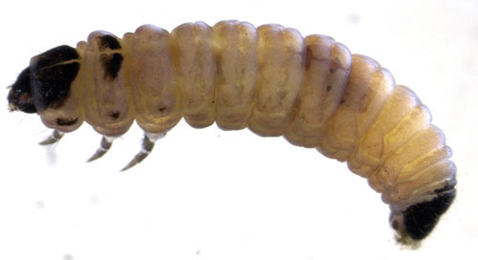 Coleophora violacea larva, lateral Image: © Willem Ellis (Bladmineerders van Europa) |
|
Coleophora violacea (Ström, 1783) [Lepidoptera: Coleophoridae]. |
|
Parornix loganella (Stainton, 1848) [Lepidoptera: Gracillariidae]. |
3# > Life-style unknown. |
|
Bohemannia auriciliella (Joannis, 1908) [Lepidoptera: Nepticulidae]. |
3a > Leaf-miner: A long usually narrow winding corridor mine with a central line of frass. Larva not living in a rolled or folded leaf, a tentiform mine or sandwiched between two more or less circular leaf sections in later instars |
3a > Leaf-miner: Either a blotch or short corridor which becomes a blotch. Larva may live in a rolled or folded leaf, a tentiform mine or sandwiched between two more or less circular leaf sections in later instars |
4a > Leaf-miner: A long, whitish smoothly-curved upper-surface mine with broken black frass. Oviposition is by means of an ovipositor; what remains is a small scar: no egg shell is visible at the start of the mine. From here a long, sometimes very long, slender, full depth corridor winds throught the leaf, not steered by leaf margin or the leaf venation. The midrib is crossed effortless; the corridor frequently also crosses itself; the section of the leaf cut off then usally turns brown and dies off. Frass in a narrow central line. The larva vacates the mine prior to pupation through an exit in the upper epidermis. The vacated larval chamber is proportionally much longer than in the case of Stigmella mines ( > 3 x longer than broad). Pupation in a silken cocoon suspended from threads attached to food plant or other vegetation. |
|
Lyonetia clerkella (Linnaeus, 1758) [Lepidoptera: Lyonetiidae]. |
4b > Leaf-miner: A narrow gallery with frass in thin central line. The moths must be bred through to distinguish S.alnetella and S.glutinosae. Ovipostion at the leaf lower surface. Then a full depth slender, corridor, often following a vein or the leaf margin for some distance. Frass in a continuous central line that nowhere is wider than one third of the corridor width. Frass never coiled. Usually only one mine in a leaf. Pupation outside the mine. |
|
Stigmella alnetella (Stainton, 1856) [Lepidoptera: Nepticulidae]. |
4c > Leaf-miner: The mine is short, with frass irregular, linear. The larva is yellow, gut-line green, and dark ventral spots. There are often several mines in a leaf. The mines are found frequently on seedlings and small plants. Egg at the underside of the leaf, close to a vein. The mine is a little widening, rather short, tortuous corridor. The first part does not encircle the egg, neither is it lower-surface.The frass line is one third to one half of the width of the corridor. The sides of the corridor are smooth, not scalloped out. Mostly several mines in a leaf, not infrequently crossing each other. Pupation external, exit slit in the lower epidermis. |
|
Stigmella betulicola (Stainton, 1856) [Lepidoptera: Nepticulidae]. |
4d > Leaf-miner: The mine is long, frass linear. Egg at the underside of the leaf, close to a vein. The mine is a very long and slender gallery, hardly widening at all. Frass in a continuous, very narrow central line. The corridor follows veins over long distances, obtaining thereby an angular appearance. |
|
Stigmella confusella (Wood & Walsingham, 1894) [Lepidoptera: Nepticulidae]. |
4e > Leaf-miner: The mine starts from brown spot, later filled with greenish frass. The mine is difficult to locate initially but becomes brown as it ages. Egg at the underside, often in a vein axil. The mine is a slender, little widening corridor. Its first part is strongly contorted; the leaf tissue that is cut off thereby is killed, mostly resulting in a brown spot. The remainder of the corridor in contrast is very little contorted, often remarkably straight, when it runs alongside a vein. The corridor is almost completely filled with coiled frass, that is green when fresh, brown later. Pupation external. |
|
Stigmella continuella (Stainton, 1856) [Lepidoptera: Nepticulidae]. |
4f > Leaf-miner: The early gallery is filled with frass, later leaving clear margins. Like Stigmella microtheriella the larva feeds on hazel or hornbeam, and its mines are often found alongside that species in the same leaf. However the mines of S. floslactella are generally wider, less angular and contain more scattered frass than those of S. microtheriella. Oviposition at the underside of the leaf, in a vein axil. Mine a slender, gradually widening corridor; the last section is clearly wider than the larva. In the first section the vaguely delimited frass line almost fills the corridor. Later the frass lies in irregular arcs and clouds, filling about one third of the width of the corridor. The trajectory of the mine is not angular, independent of the leaf venation. Pupation external, exit slit in the upper epidermis. |
|
Stigmella floslactella (Haworth, 1828) [Lepidoptera: Nepticulidae]. |
4g > Leaf-miner: The mine is long, filled with green frass to ¼, then linear. Oviposition generally at the underside of the leaf. The mine is a slender corridor that hardly widens, even towards the end. The first third is stuffed with diffuse greenish brown frass. After a moult the frass pattern changes completely, into a very narrow, continuous black line. The mine often follows a thick vein over a long distance, but the larva is capable of crossing thick veins, even the midrib. |
|
Stigmella lapponica (Wocke, 1862) [Lepidoptera: Nepticulidae]. |
4h > Leaf-miner: The mine is contorted, starting underside, frass linear. Egg at the underside of the leaf, mostly close to a vein. The mine is a fairly slender corridor that even towards the end hardly widens. The first part consists of a some close loops around the oviposition site; this part generally is lower-surface. The later part is much less contorted, with a frass line that occupies one third to one half the width of the gallery. The sides of the corridor are irregularly scalloped out. Usually no more than one mine per leaf. Pupation external, exit slit in the lower epidermis. |
|
Stigmella luteella (Stainton, 1857) [Lepidoptera: Nepticulidae]. |
4i > Leaf-miner: The frass is brown and in arcs, with narrow clear margins (unlike continuella where the green frass completely fills the gallery). Oviposition on the underside of the leaf. Then a rather slender gallery, hardly widening, even towards the end. The corridor is not strongly contorted, not even in its first section; no browned spot in the leaf at the start of the mine. Sides of the corridor irregularly scalloped. The corridor mostly begins close to the leaf margin, often near the tip of the leaf. The coiled frass is brown or black, even in fresh mines; the frass fills most of the width of the corridor, but always leaves a transparent zone at either side. Pupation external; exit slit in the upper epidermis. |
|
Stigmella sakhalinella Puplesis, 1984 [Lepidoptera: Nepticulidae]. |
4j > Leaf-miner: Long, full depth mine, starting at an oviposition scar, mostly in the distal part of the midrib; the scar may be swollen and gall-like. Frass line variable in width, sometimes quite broad. Usually the corridor loosely follows the leaf margin, and the part of the leaf that is cut off from the centre dies off. The larvae live in spring, when the leaf is unfolding; later in summer affected leaves are recognisable because the tip of the leaf and parts of the marginal teeth are missing, by remnants of the corridor and by a general disfiguring of the leaf. The larva leaves the mine before pupation. |
|
Anoplus plantaris (Naezen, 1794) [Coleoptera: Curculionidae]. |
5a > Leaf-miner: Larva living in a rolled or folded leaf or a tentiform mine in later instars |
5b > Leaf-miner: Larva not living in a rolled or folded leaf, a tentiform mine or sandwiched between two more or less circular leaf sections in later instars, usually forming a blotch mine or a corridor mine which becomes a blotch mine |
6a > Leaf-miner: The larva begins with a short, full depth corridor, often along the midrib or a thick vein. Most of the mine with a thick frass line. The larva soon leaves the mine, and starts causing window-feeding, later eating holes in the leaf. The larval chamber (the space occuped by the larva, while in the mine, obviously free of frass) is more than three times as long as wide. |
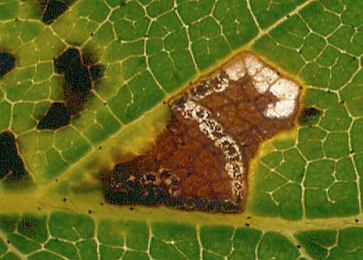 Mine of Bucculatrix demaryella on Betula pubscens Image: © Willem Ellis (Bladmineerders van Europa) |
|
Bucculatrix demaryella (Duponchel, 1840) [Lepidoptera: Bucculatricidae]. |
6b > Leaf-miner: The larvae mine the leaves at first, then create small feeding windows. Small, full depth, hook-like corridor, usually in a vein axil, with a proportionally large larval chamber. The remainder of the mine almost entirely stuffed with frass. At the start if the mine an iridescent egg shell. The larvae soon leave their mine and start living free on the leaf. The pupa and white ribbed cocoon are illustrated in British leafminers. |
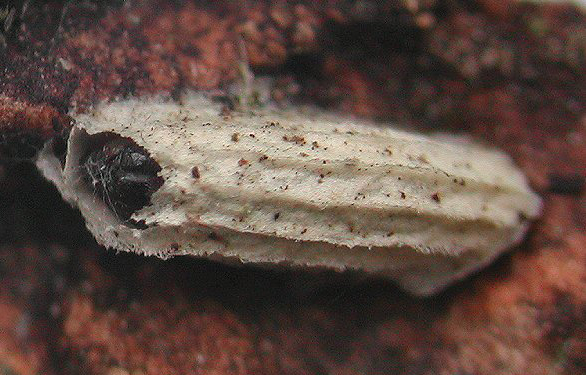 Bucculatrix thoracella cocoon Image: Rob Edmunds (British leafminers) |
|
Bucculatrix thoracella (Thunberg, 1794) [Lepidoptera: Bucculatricidae]. |
6c > Leaf-miner: The larvae feed on a range of deciduous trees, windowing leaves in autumn and eating the buds, catkins, young shoots and then spun leaves in the spring. Cocoon formed in soil or where the larva fed British leafminers. |
|
Gypsonoma dealbana (Frölich, 1828) [Lepidoptera: Tortricidae]. |
6d > Leaf-miner: The larva starts making a corridor of a few mm, followed, and mostly overrun, by a circular blotch of 4-5 mm diameter. Generally several larvae feed in a single leaf, creating a distinctive pattern of feeding windows. The larvae then cut out circular cases and drop to the leaf-litter to continue feeding, leaving behind a leaf containing many circular or oval cut-outs. |
|
Incurvaria pectinea Haworth, 1828 [Lepidoptera: Incurvariidae]. |
6e > Leaf-miner: The mine in the petiole and midrib leads to an oval blotch, then a cut-out in leaf-blade. The larva begins its life as a borer in the pith of a twig. Only when it is almost full grown it enters a petiole, then the midrib, of a leaf. The leaf becomes starved that way, and turns somehwat pale. From the midrib a short full depth corridor runs into the blade, generally in the basal part of the leaf. The corridor usually is quite short but when it happens to be longer a central frass line is visible. Finally an oval excision of about 3 x 5 mm is cut out, in which the larva drops to the ground. |
|
Heliozela hammoniella Sorhagen, 1885 [Lepidoptera: Heliozelidae]. |
6f > Leaf-miner: A rather stubby, gradually widening, corridor that usually begins near the leaf tip and descends along the leaf margin (especially in the first generation). Finally an almost perfectly circular excision is cut, in which the larva drops to the ground for pupation. A broad gallery with scattered frass, usually along the edge of the leaf, ending at a circular blotch from which a case is cut leaving a round hole. |
|
Orchestes rusci (Herbst, 1795) [Coleoptera: Curculionidae]. |
6g > Leaf-miner: The larva mines young leaves and the narrow initial mine ends in a blotch. The larva cuts out a section of the leaf and over winters in this on the ground. Long, very narrow corridor that may wind several times through the leaf, freely crossing the midrib. The corridor often cuts off parts of the leaf, that die as a result. The corridor does not increase in width, until it abruptly widens into an irregular elongate blotch. In the end of the blotch an oval excision is made, c. 4 mm long, in which the larva drops to the ground for pupation. Mines in the very youngest leaves. |
|
Phylloporia bistrigella (Haworth, 1828) [Lepidoptera: Incurvariidae]. |
6h > Leaf-miner: A broad initial mine from tip to base of leaf, which later contracts. It then folds the leaf edge, later it rolls the whole leaf longitudinally. Compare with C. betulicola, which rolls the leaf transversally. At first the mine is epidermal and rather large, sometimes even occupying the entire length of the leaf. At a later stage the larva begins to consume the tissue below the epidermis, and the mine becomes a tentiform one; the leaf is strongly contracted by then. The epidermis is brown. The mine may be lower-surface or upper-surface. After the mine has been vacated the larva moves twice. At first it lives in a rolled, sometimes just folded, leaf margin, next in a leaf that has been rolled lengthwise. Pupation in a cocoon at the underside of a leaf. Despite the scientific name, the larvae feed on birch leaves. Pupation under a silk membrane on underside of leaf. Pupation in a transparent, yellow-shining cocoon at the leaf margin. |
|
Caloptilia populetorum (Zeller, 1839) [Lepidoptera: Nepticulidae]. |
6i > Leaf-miner: The larva mining the leaves initially and then living inside a rolled leaf in later instars . The mine starts with an unconspicuous epidermal corridor, mainly visible by a reddish brown frass line. During the following larval stage a blotch is formed, that quickly develops into a tentiform mine; the epidermis is brown. Generally the mine is lower-surface, but upper-surface mines are not rare. Frass in a mass of grains in a corner of the mine. After having left its mine the larva moves twice. First it lives in a rolled (sometimes just folded) leaf margin, after that in a leaf that is transverely rolled downwards, starting from the leaf tip. Pupation in a white, strongly shining, parchment-like cocoon that is fixed with silk to the leaf margin. |
|
Caloptilia betulicola (M. Hering, 1928) [Lepidoptera: Gracillariidae]. |
6j > Leaf-miner: Initially a lower epidermal gallery which leads to a blotch at the leaf-edge. Subsequently creates two or three cones by folding the edge or tip of a leaf downwards. The mine begins with an unusually long lower-surface epidermal corridor that often follows the midrib for some distance, but finally turns towards the leaf margin, where a small blotch is made of up to 1 cm in diameter. The blotch initially is fully epidermal, but later the larva starts consuming parenchyma, silk is deposited, and the blotch begins to develop into a somewhat contracted tentiform mine. In the end the mine is vacated and the larva continues living freely under a leaf fold that has been fixed with silk, or in a leaf tip that has been turned into a cone. Pupation in a shiny cocoon at the underside of the leaf. |
|
Caloptilia stigmatella (Fabricius, 1781) [Lepidoptera: Nepticulidae]. |
6k > Leaf-miner: The mine is in the upper epidermis of a leaf, usually over midrib or vein. The mine is at first silvery, later with brown speckling. Silvery, upper-surface, epidermal tentiform mine, centered over the midrib or a heavy lateral vein. Unlike P. leucographella, with which this species shares some host plants, the upper epidermis looks dirty by the presence of numerous fine black-brown specks of frass. The epidermis remains without folds until the mine becomes strongly contrated. Young mines look like a streak of silver on top of a vein. |
|
Phyllonorycter corylifoliella (Hübner, 1796) [Lepidoptera: Gracillariidae]. |
6l > Leaf-miner: A small Phyllonorycter-like mine initially, but with brown rather than green lower epidermis. Later in one or more successive cones formed by folding downwards the edge or tip of a leaf. The mine begins as an inconspicuous lower surface corridor, mainly recognisable by its brown line of frass. In the next larval stage a lower-surface blotch is made, that soon develops into a tentiform mine; its epidermis turns brown. Frass in a clump in a corner of the mine. After leaving the mine the larva continues feeding in a downwards folded leaf margin, that is fixed with silk. |
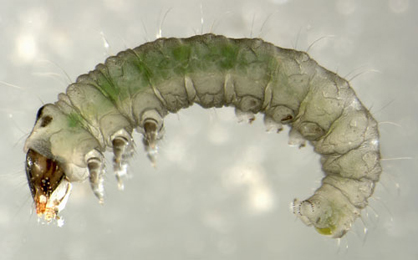 Parornix betulae larva, lateral Image: © Willem Ellis (Bladmineerders van Europa) |
|
Parornix betulae (Stainton, 1854) [Lepidoptera: Gracillariidae]. |
6m > Leaf-miner: The initial mine expands to form a full depth blotch. It resembles Phyllonorycter tenerella, but has a mottled lower surface. It then forms two folds. Small, angular, full depth blotch, often in a vein axil. Lower, in the end also upper, epidermis brown. The larva deposits some silk in the mine, but the quantity is so low that the mine remains practicaly flat. Later the larva leaves the mine and continues feeding within a downfolded leaf margin or leaf tip. |
|
Parornix carpinella (Frey, 1863) [Lepidoptera: Gracillariidae]. |
6n > Leaf-miner: A small mine (about 1cm long), which strongly arches the leaf. The mine of Parornix betulae can appear similar, but the underside becomes brown whereas the mine of P. anderidae stays green. Small lower-surface tentiform mine; epidermis pale green, rather weakly folded. The pupa lies without a cocoon in the mine. |
|
Phyllonorycter anderidae (W. Fletcher, 1885) [Lepidoptera: Gracillariidae]. |
6o > Leaf-miner: A large mine, 15-20 mm long, more than six creases, in the lower epidermis. Relatively large, lower-surface tentiform mine; epidermis rather strongly folded. Pupa in the mine, in a white cocoon. |
|
Phyllonorycter cavella (Zeller, 1846) [Lepidoptera: Gracillariidae]. |
6p > Leaf-miner: The mine is oval on Q. ilex (note - there may be several mines in the leaf), and similar to P. quercifoliella on deciduous oaks. It is between adjacent veins on beech and hornbeam. Small, oval, lower-surface tentiform mine, 9-14 mm long, mostly between two lateral veins. The lower epidermis with a single sharp fold (sometimes forked near its end). Pupa in very flimsy cocoon, that contains a bit of frass laterally and at the rear end. |
|
Phyllonorycter messaniella (Zeller, 1846) [Lepidoptera: Gracillariidae]. |
6q > Leaf-miner: The larva forms a blotch mine on the underside of a leaf, often quite small, but puckering the leaf noticeably. The mine is 10-15 mm long, 1-6 creases in lower epidermis. Small lower surface tentiform mine; the lower epidermis is greenish yellow and weakly folded. Pupation within the mine in a cocoon that in the summer generation is so flimsy that sometimes it seems to be missing, while in the autumn generation it is quite tough. All frass in a corner of the mine. |
|
Phyllonorycter ulmifoliella (Hübner, 1817) [Lepidoptera: Gracillariidae]. |
7a > Leaf-miner: A very clear blotch, without preceding corridor, usually harbouring several crimson marbled larvae. The mine mostly begins near the base of the midrib. Most frass is ejected from the mine, but some of the grains are trapped in a loose spinning below the leaf, that has been made by the larvae during excursions. The larvae can leave their mine and restart elsewhere. Makes large blotch mines. There may be several larvae in each blotch. Frass is ejected from the mine and collects in a light web spun beneath the mine. The larvae can change leaves to feed. The larva overwinters within a cocoon spun in the leaf. The larvae hibernate individually in a discoid cocoon. |
|
Atemelia torquatella (Lienig & Zeller, 1846) [Lepidoptera: Yponomeutidae]. |
7b > Leaf-miner: The mine begins as a contorted gallery, when the young larva can be seen to have dark plates on each segment. These plates are later lost and the gallery becomes a blotch with scattered frass. Mine begins at a globular, black, lower-surface egg shell. From there starts a short tortuous corridor, that widens into a blotch, often between to lateral veins. Frass dispersed. Pupation outside the mine. |
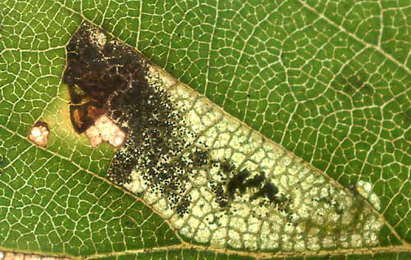 Mine of Ectoedemia minimella on Betula pubescens Image: © Willem Ellis (Bladmineerders van Europa) |
|
Ectoedemia minimella (Zetterstedt, 1839) [Lepidoptera: Nepticulidae]. |
7c > Leaf-miner: The larvae mine the leaves of birch, creating a distinctive mine which begins as a dark circular blotch, and is then extended into a larger pale blotch with a darker central circle. Sometimes several mines are found in one leaf. Egg usually at the underside of the leaf. The mine is a roundish, often almost circular, primary, upper-surface blotch without a trace of an initial corridor; often several mines in leaf. The mine has a conspicuous dark centre, where the larva often retreats. Young mines consist of only the dark centre, without the light periphery. Also the frass is accumulated here; unlike in Leucoptera malifoliella the frass is not draped in arcs around the centre. |
|
Ectoedemia occultella (Linnaeus, 1767) [Lepidoptera: Nepticulidae]. |
7d > Leaf-miner: Blotch clouded, with some green matter left in mine. Several larvae (2-4) in one mine. Large full depth blotch, adjacent to the leaf margin. The mine is not completely eaten out, which gives it a greenish or off-white appearance. Frass in threads, that seem to be somewhat shorter than in other Eriocrania's. The mine harbours 2-4 strikingly hyaline larvae. Pupation in the ground. Older mines wither and wear off; in summer no trace of them is left. |
|
Eriocrania cicatricella (Zetterstedt, 1839) [Lepidoptera: Eriocranidae]. |
7e > Leaf-miner: The early gallery starts in the centre of the leaf. It is a linear track which widens to a large blotch at the leaf edge, with frass in long threads. Corridor, generally beginning in the neighbourhood of the midrib, rather gradually widening into a very large blotch. Frass in long threads. Pupation in the ground. |
|
Eriocrania salopiella (Stainton, 1854) [Lepidoptera: Eriocranidae]. |
7f > Leaf-miner: A blotch with large dark grey larva - discarded grey larval skin visible in vacated mine. The mine starts by the edge of the leaf. Large, white, primary, full depth blotch, following upon a very short corridor. The blotch begins adjacent to the leaf margin, expanding deeper into the leaf. Frass in striking, long threads. Pupation in the soil. Vacated mines shrivel and wither away; later in summer no a trace remains. |
|
Eriocrania sangii (Wood, 1891) [Lepidoptera: Eriocranidae]. |
7g > Leaf-miner: The larva mines in a birch leaf, forming a large blotch (UKMoths) starting at or near the leaf edge and then widens into a blotch. Oviposition a few mm from the leaf margin; here begins a corridor of some mm, filled with granular frass. This corridor suddenly widens into a large full depth white bloth, with frass in long threads. The blotch remains adjacent to the leaf margin, and often engulfs the initial corridor. Almost always one larva in the mine (unless by coalescence of two mines). Pupation external. Older mines wither and desintegrate, and cannot be found later in the summer. |
|
Eriocrania semipurpurella (Stephens, 1835) [Lepidoptera: Eriocranidae]. |
7h > Leaf-miner: A linear track widens to blotch, frass in long threads. Corridor, generally starting not far from the midrib, at a conspicuous, yellowish oviposition scar, suddenly and somewhat angular widening into a full depth blotch. Often the corridor is overtaken by the blotch, but it remains recognisable in the frass pattern. Frass in long threads. Pupation in the ground. |
|
Eriocrania sparrmannella (Bosc, 1791) [Lepidoptera: Eriocranidae]. |
7i > Leaf-miner: A rather large, clear, partly full depth blotch that begins in the axil of a thick lateral vein. Often the ovipostion leaves a greyish-green scar. Generally several mines in a leaf. The mine expands within the confines of the midrib and two lateral veins; only close to the leaf margin, where the lateral veins are thin, the mine may trespass over a vein. The larvae of sawflies have at least six thoracic legs (although they may be reduced or absent), a head capsule and chewing mouthparts with opposable mandibles but no abdominal legs. |
|
Fenusa pumila Leach, 1817 [Hymenoptera: Tenthredinidae]. |
7j > Leaf-miner: Large blotch, starting from the leaf margin. The very first triangular part of the mine is filled with a dense mass of frass, caused by lateral movements of the larva that actually press the frass in this first mine segment. The mine seems full depth, but actually is upper-surface, abeit very deep and (fresh) only very weakly greenish. Pupation outside the mine. The larvae of sawflies have at least six thoracic legs (although they may be reduced or absent), a head capsule and chewing mouthparts with opposable mandibles but no abdominal legs. |
|
Fenusella nana (Klug, 1816) [Hymenoptera: Tenthredinidae]. |
7k > Leaf-miner: The mine starts at or near the leaf edge and widens to a blotch with frass in long threads. Large, white, full depth blotch along the leaf margin. Frass in long threads. Old mines wither and disintegrate, and cannot be found any more later in the summer. |
|
Heringocrania unimaculella (Zetterstedt, 1839) [Lepidoptera: Eriocranidae]. |
7l > Leaf-miner: Large blotch, begining at the leaf margin (there is no accumulation of frass). The oldest part of the mine with a charcteristic, wine red colour. Most of the frass is ejected through a narrow slit in the leaf margin. The larva makes an discoidal cocoon within the mine. Hibernation in the larval stage. The larvae of sawflies have at least six thoracic legs (although they may be reduced or absent), a head capsule and chewing mouthparts with opposable mandibles but no abdominal legs. |
|
Heterarthrus nemoratus (Fallén, 1808) [Hymenoptera: Tenthredinidae]. |
7m > Leaf-miner: A circular or oval brownish blotch with a central spiral of dense blackish frass (British leafminers), sometimes several mines in one leaf. Oviposition is at the leaf underside, well away from the leaf margin; the egg has a fine reticulate surface. The mine is a rather large, perfectly circular blotch without a trace of a preceding corridor. Around the dark centre the frass, glued to the upper epidermis is arranged in distinct arcs. Pupation in a silken cocoon, usually on detritus. |
|
Leucoptera malifoliella (O. Costa, 1836) [Lepidoptera: Lyonetidae]. |
7n > Leaf-miner: The larva mines the leaves of various roseaceous trees, such as blackthorn and apple, forming a gallery leading to a blotch. Eggs are deposited in the underside of a leaf, well away from the margin, often several per leaf. Around the oviposition site a cavity develops that in the end often leaves a hole in the leaf. Then a narrow, hardly widening, winding corridor, largely filled with a broad reddish brown frass line. The corridor abruptly widens into a wide, full depth blotch, that often lies against the leaf margin. The larva may leave its mine and continue elsewere, even on a different leaf. Note that the first blotch may already lie on a different leaf. Frass dispersed, in oval granules. Most frass is ejected through semicircular cuts along the outer limit of the blotch; part of it is often trapped in strands of silk under the leaf. The pupal cocoon is suspended from silken 'guy ropes' and closely resembles that of L. clerkella. |
|
Lyonetia prunifoliella (Hübner, 1796) [Lepidoptera: Lyonetiidae]. |
7o > Leaf-miner: Oviposition in the underside of the midrib or a thick lateral vein; later a large scar is visible there. Initially the larva tunnels in the midrib or vein, that inflates and disfigures somewhat as a result. Then the larva starts a corridor in the leaf blade, quite narrow at first, but strongly widening as the larva approaches the leaf margin or leaf tip. The mine is reddish brown in colour. The mature larva makes itself a dark brown globular cocoon in the mine and pupates there. Because the mine is made at a time that the leaf still is unfolding, the leaf becomes permanently rumpled. In the course of the summer the mine erodes away, but the combination of the oviposition scar, the swolllen mibrib and the frayed leave missing a large part of its distal half remains unmistakable, as testaceus including calceatus). |
|
Orchestes calceatus (Germar, 1821) [Coleoptera: Curculionidae]. |
| 7p > Leaf-miner: Oviposition in the midrib. From there a corridor the larva enters the lamina which suddenly and strongly widens. The larva finally pupates in a globular cocoon inside the mine. Because the mine is formed when the leaf already is fully developed mined leaves have a normal shape. |
|
Orchestes iota (Fabricius, 1787) [Coleoptera: Curculionidae]. |
7q > Leaf mine:Blotch, starting in the centre of the leaf. An ill-defined accumulation of frass in its first part. The blotch develops with little consideration of the major veins. Several mines may occur in a leaf, and coalesce into one large blister. The larvae of sawflies have at least six thoracic legs (although they may be reduced or absent), a head capsule and chewing mouthparts with opposable mandibles but no abdominal legs. |
|
Profenusa thomsoni (Konow, 1886) [Hymenoptera: Tenthredinidae]. |
| 7r > Leaf-miner: Generally small, upper-surface, pear-shaped mines, half of their surface stuffed with frass. In the frass-free part an oval, flattened larva. Often several mines in a leaf. Prior to oviposition the larvae eat, a large number of tiny holes in the leaves. |
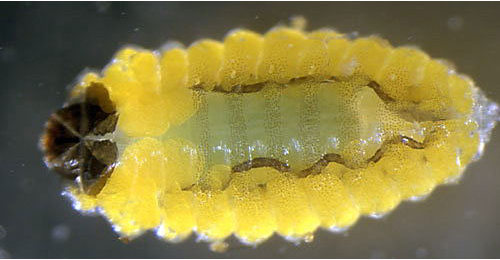 Rhamphus pulicarius larva, dorsal Image: © Willem Ellis (Bladmineerders van Europa) |
|
Rhamphus pulicarius (Herbst, 1795) [Coleoptera: Curculionidae]. |
7s > Leaf-miner: The larvae feed on the leaves of lime and birch, mining the leaves when young. Oviposition at the leaf upperside. Mine a short, irregular, full depth corridor, always at the leaf margin, generally in the tip of the leaf. Frassly broadly scattered. The older larva lives free on the leaf. |
|
Roeslerstammia erxlebella (Fabricius, 1787) [Lepidoptera: Roeslerstammiidae]. |
7t > Leaf-miner: Large, transparent, in fresh condition pale green blotch that begins at the leaf margin, without an accumulation of frass. Mine and larva are undistinguishable from those of S. vicina, but vicina larvae live from mid May until mid June, while the larvae of betuleti are found only in August - October. Mines and larvae on Alnus viridis have recently been recorded from Orkney by Derek Mayes (pers. comm.), which given the time of year are most likely Scolioneura betulae. The larvae of sawflies have at least six thoracic legs (although they may be reduced or absent), a head capsule and chewing mouthparts with opposable mandibles but no abdominal legs. |
|
Scolioneura betuleti (Klug, 1816) [Hymenoptera: Tenthredinidae]. |
7u > Leaf-miner: Large, transparent, in fresh condition pale green blotch that begins at the leaf margin, without an accumulation of frass. Mine and larva are undistinguishable from those of S. vicina, but vicina larvae live from mid May until mid June, while the larvae of betuleti are found only in August - October. |
|
Scolioneura vicina Konow, 1894 [Hymenoptera: Tenthredinidae]. |
7v > Leaf-miner: Full depth blotch, invariably beginning at the leaf tip or the tip of a leaf lobe or tooth. Oviposition site covered by a black, shining drop of hardened secretion. Frass generally in long threads, but sometimes in elongated granules. Pupation in the mine, not in a cocoon. |
|
Trachys minutus (Linnaeus, 1758) [Coleoptera: Buprestidae]. |
7w > Leaf-miner: Full depth corridor, beginning at the base of the midrib and very roughly following the leaf margin; all the while the corridor widens, until almost the entire leaf has been mined out. Frass, as coarse grains or thread fragments, in the centre of the mine. The larva pupates in the mine, in a globular cocoon made of secretion. |
|
Tachyerges pseudostigma (Tempère 1982) [Coleoptera: Curculionidae]. |
7x > Leaf-miner: Oviposition in the base of the midrib, without giving rise to an oviposition scar. The larva initially bores inside the midrib. Later it leaves the midrib, forming a broad corridor in the blade, that widens into a blotch. Finally thelarva pupates in a globular cocoon inside the mine. Because the mine develops at a time that the leaf is fully developed, mined leaves are not disfigured. |
|
Tachyerges stigma (Germar) [Coleoptera: Curculionidae]. |
| Last updated 09-Oct-2019 Brian Pitkin | ||
